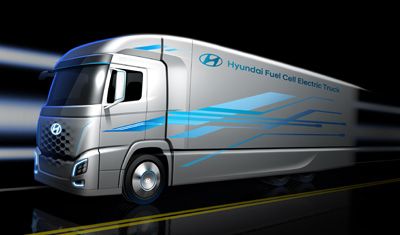
Hydrogen Fuel Cells Still Packed with Promise
In the transportation sector, fuel cell technology has long been on the brink of breaking through for a variety of medium- and heavy-duty applications. We’re still not quite there yet, the experts say – but the promise continues.
“Increasingly, the toughest remaining challenges for heavy-duty fuel cell trucks relate to the hydrogen fuel they run on,” said Jon Leonard, senior vice president at Gladstein, Neandross & Associates (www.gladstein.org), a clean transportation and energy consulting company. “Like compressed natural gas vehicles, most fuel cell vehicles run on compressed hydrogen [CH2] that must be carried onboard the vehicle using heavy, expensive, high-pressure tanks. Although this presents tradeoffs on cost, range and other factors, onboard CH2 storage is robust and proven.”
Other challenges include the high cost of the hydrogen fuel and its limited availability due to a paucity of hydrogen fueling stations. “Moreover,” Leonard added, “the limited number of existing hydrogen stations are largely geared for light-duty vehicles like the Toyota Mirai, Honda Clarity, etc. The only hydrogen stations that can accommodate heavy-duty vehicles are mostly found on transit properties.”
All the same, there is forward movement. Light-duty fuel cell vehicles manufactured and sold by the likes of Toyota, Honda, Hyundai and Mercedes-Benz are proving their worth – and inspiring the promise of other, heavier-duty applications in the future.
Morry Markowitz, president of the Fuel Cell and Hydrogen Energy Association (www.fchea.org), sees medium- and heavy-duty applications as a “sweet spot” for fuel cell technology. First, he said, fleet applications can help provide efficiencies in the buildout of infrastructure. And second, fuel cell technology is similar to current systems, in which the size of the fuel cell can be scaled to meet power requirements. According to Markowitz, many business customers and policymakers see it like this: “Fuel cells for medium- and heavy-duty trucks seem to be the only solution that can replicate the current operator’s experience for range and fueling/refueling time of the fleet.”
Markowitz also often comes across the misconception that battery electric vehicle technology is more mature than fuel cell vehicle technology, he said, but that’s just not the case. As a zero-emission vehicle application, “it’s actually moving at a more rapid pace.”
A Potential Game Changer
Leonard, for his part, points out Toyota’s recent announcement that it will build heavy-duty truck fuel cell systems for Class 8 trucks as a “potential game changer.”
“Toyota is now in the beta (‘2.0’) stage of building, testing and demonstrating this system,” he said. “Notably, Toyota does not seem likely to manufacture Class 8 trucks (of any architecture). Instead, it appears likely to supply fuel cell drivetrain systems to heavy-duty truck OEMs. Still, for a major world-class automotive OEM like Toyota – which owns medium-duty truck OEM Hino – to make major investments in heavy-duty fuel cell drivetrains is a major step forward.”
In addition, Leonard noted, other heavy-duty truck OEMs like Kenworth are working on fuel cell architectures for Class 8 trucks, too, collaborating with innovative electric-drivetrain providers like TransPower and US Hybrid to advance the technology. And Ballard Power Systems will likely bring its PEM fuel cell stack for use in heavy-duty applications to market in 2019. “The company has said that this new stack will reduce total cost of ownership, has a longer operating lifetime and has a higher power density, among other benefits,” Leonard said.
When it comes to use in, say, bucket trucks and digger derricks, Leonard said that most of these types of applications require power takeoff capability. The value proposition here would likely be similar to hybrid-electric architectures, he said, but until there are demos of near-commercial products, unknowns remain.
“As with broader applications, much of the answer relates to the cost of hydrogen fuel,” Leonard said. “Right now, hydrogen costs $10 to $15 per kilogram, which translates to about $12 to $18 per diesel gallon equivalent. … The fuel cell system’s higher efficiency helps offset the much higher cost, but this still has significant cost impacts on end users.”
Without proportional government subsidies, no alternative fuel platform makes economic sense to end users if it imposes both higher capital costs and higher fuel costs, he said. “In many trucking operations, fuel costs are, after labor costs, the leading determinant of total operational cost.”
About the Author: Fiona Soltes is a longtime freelance writer based just outside Nashville, Tennessee. Her clients have represented a variety of sectors, including fleet, engineering, technology, logistics, business services, retail, disaster preparedness and material handling. Prior to her freelance career, Soltes worked as a staff writer at newspapers in Tennessee and Texas.
*****
Keeping an Eye on the Hydrogen Fuel Cell Horizon
Those interested in the advance of fuel cell technology can hone in on several different areas.
First, according to Jon Leonard, senior vice president at Gladstein, Neandross & Associates, utility fleet professionals should monitor progress with light-duty fuel cell vehicles and the extent that such progress appears to be transferring upward to medium-duty trucks. In particular, they can keep an eye on close relationships between light-duty and medium-duty OEMs, such as Toyota’s relationship with Hino.
Second, utility fleet professionals should monitor whether the buildout of hydrogen stations “at least meets the announced expectations and magnitude,” Leonard said.
Third, Morry Markowitz, president of the Fuel Cell and Hydrogen Energy Association, expects to see “more and more truck manufacturers and outfitters looking at fuel cells,” increasing both awareness and availability.
And finally, Markowitz said, “We’ll most likely see greater demand by policymakers toward zero emissions in fleets in the medium- and heavy-duty range.”


